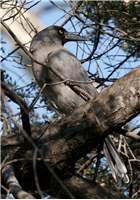Family
Artamidae
Genus
Strepera
Species
versicolor
Threats/Control Methods - Regional
This species is declining in parts of Australia where extensive areas of land are being cleared. Their regional native woodland habitat is listed as an Endangered Ecological Community due to land clearing for urban development and agriculture, grazing, firewood collection and weed and pest invasions.
Threats/Control Methods - Local
The fragmentation of suburban reserves may cause a decline in population numbers.
Local/Urban Actions
The preservation of large areas of suitable woodland habitat is key to the survival of this species. This is facilitated through local Landcare groups or Greening Australia. Gardeners can encourage the species by ensuring their yard consists of a good mix of trees, shrubs and ground litter.
Common Names
Grey Currawong, Black-winged Currawong, Brown Currawong, Clinking Currawong, Squeaker
Distinguishing Features
This large species of 45-50cm has silvery -grey plumage with white markings on the tip of the tail, on the rump and throughout the wings. It has a large, strong looking beak and yellow eye. Young birds are a dull grey-brown colour with dark brown eyes.
Survey Techniques
Call and visual identification.
Species Call
A high pitched, clear, metallic clicking 'kling-kling-kling' or chring-chring'.
Similar Species
The Pied Currawong (Strepera graculina ) and the Black Currawong (Strepera fuliginosa) are very similar in size and shape, however they are black instead of grey. The Australian Raven (Corvus coronoides ) and the Little Raven (Corvus mellori ) lack the white markings and the yellow eye. The White-winged Chough (Corcorax melanorhamphos ) is also similar, with a downcurved beak and a red eye.
Distribution
This species is found across the southern part of Australia and in TAS. It is most abundant in the mountains between VIC and NSW and in WA east of Perth. In the Canberra region it is only seen in consistent numbers in areas close to large nature reserves.
Country of Origin
Australia
Conservation (Pet/Pest) Status - Regional
This species is far less common than the Pied Currawong (Strepera graculina ) but its population is stable.
Conservation (Pet/Pest) Status - National
Secure, not listed under the EPBC Act 1999.
LSCCES Population
Very low numbers of Grey Currawongs were found at BMt, Turner, BMP, Civic West, ANBG and ANU.
Associated vegetation community
The Grey Currawong inhabits forest and woodland areas. It will also survive in heath, mallee, small vegetation stands or orchards.
Limiting Resources
Grey Currawongs will only be found in areas will large areas of bushland reserves close-by. It has not adapted to urbanisation as successfully as the Pied Currawong (Strepera graculina ), as it still prefers natural food and shelter within areas with different layers of vegetation.
Breeding
The breeding season runs from August to December. The nest is a shallow bowl of sticks, placed on a fork of braches in a tree's outer leafy canopy. The 2-3 eggs in each clutch are mottled brown colour. The female incubated the eggs for 21 days and then both parents feed the young. One full breeding event takes about 15 weeks.
Behaviour
The Grey Currawong finds the Canberra winters too harsh, moving down to warmer forested areas during this time.
Functional Group
Food Species
This species searches for food in the crevices of eucalypt branches and loose bark. It has a wide diet, eating small animals such as birds, rodents and frogs as well as eggs, insects, seeds, fruits and dead animals.
Predators
This strong bird is not as susceptible to attacks from feral or domestic animals than other bird species, experiencing limited predation. However, it will eat other small birds.
Interesting Fact
The Grey Currawong has six subspecies across Australia. They all look fairly unique and were originally considered as separate species.
References - (reader suitability of references, P=Primary teachers, S=Secondary students, T=Tertiary students and researchers)
Books:Freudenberger, D. 2001. Bush for the birds: Biodiversity enhancement guidelines for the Saltshaker Project, Boorowa, NSW. Consultancy report to Greening Australia ACT and SE NSW Inc. CSIRO Sustainable Ecosystems. Canberra. S, T
Morcombe, M. 2000. Field Guide to Australian Birds. Steve Parish Publishing. Archerfield. Australia P, S, T
Pizzey, G. 2000. The Graham Pizzey & Frank Knight Field Guide to the Birds of Australia. Angus & Robertson, Sydney. P, S, T
Veerman, P. 2003. Canberra Birds: A report on the first 21 years of the garden bird survey. Philip Veerman and Canberra Ornithologists Group. Canberra. S, T
Internet: Birds in Backyards. 2006. [online]. Available at:http://www.birdsinbackyards.net P, S, T
Canberra Ornithological Group (COG). 2004. Birds of Canberra Gardens. COG and the ACT Department of Urban Services. [online]. Available at:http://garden.canberrabirds.org.au/ P, S, T
Online Publications:ACT Government. 2004. Woodlands for Wildlife: ACT Lowland Woodland Conservation Strategy. Action Plan No. 27. Environment ACT, Canberra. [online]. Available at: http://www.environment.act.gov.au/nativeplantsandanimals/threatecspec/woodlandsstrategy S, T
Nix, H. and Cunningham, R. 2006. Birds of the Lower Sullivans Creek Catchment, Canberra ACT. Prepared for the Life in the Suburbs project using data from the Lower Sullivans Creek Catchment Ecological Survey (LSCCES). Australian National University. Canberra. [online]. Available at: http://www.lifeinthesuburbs.com.au/category.php?id=65 S, T

 Top
Top Top
Top